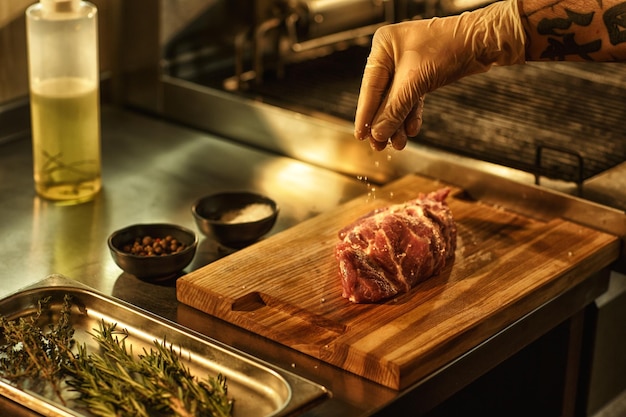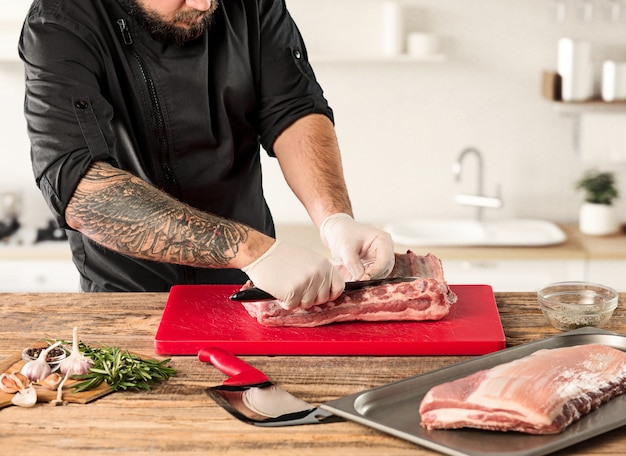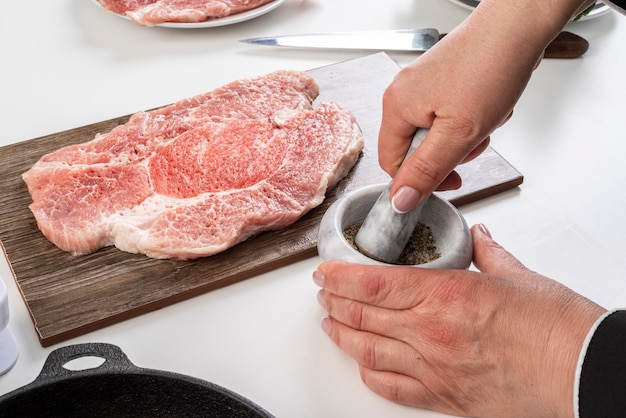Let's talk steak, folks. Not those flimsy, pre-packaged supermarket offerings that practically beg for a microwave. I'm talking about the real deal, the kind that makes your mouth water just thinking about it. A steak that's got a juicy, flavorful interior and a beautifully seared exterior, demanding to be savored.
This is your one-stop shop for perfecting your steak game. We'll go beyond basic grilling and pan-frying, exploring different cuts, prepping techniques, and even some fancy finishing touches. Ready to elevate your steak game? Let's dive in!
(Part 1)
choosing the right cut

You can't expect to cook a perfect steak if you haven't got the right starting point. The cut of meat plays a huge role in the final outcome, influencing everything from the flavor profile to the texture.
steak cuts for Beginners:
Sirloin: A classic for a reason. It's got a nice balance of flavor and tenderness, thanks to a good amount of marbling. It's also a good value for your money.
Rib-eye: This is the king of steaks for me, and many others. It's incredibly tender, full of juicy flavor, and boasts a generous amount of marbling. Be prepared to pay a bit more for this premium cut.
flank steak: A leaner option, perfect for those who prefer a more pronounced flavor. It's got a great texture that holds up well to grilling and stir-frying.
steak cuts for the Adventurous:
new york strip: Leaner than a ribeye, with a more distinct, beefy flavor. It's fantastic for grilling or pan-frying.
Tenderloin (filet mignon): The ultimate in tenderness, with a buttery-smooth texture. It's perfect for special occasions, but be prepared for a heftier price tag.
Understanding the Anatomy of a Steak

Before we jump into cooking, let's take a moment to understand the anatomy of a steak, specifically the "marbling," which is crucial for flavor and tenderness. Marbling refers to the streaks of fat that run through the muscle fibers of the meat. These little fat deposits melt during cooking, adding juicy flavor and making the steak more tender.
The More the Marbling, The Better:
Prime: The highest grade of beef, with the most marbling, resulting in the most tender and flavorful steak.
Choice: A good balance of flavor and tenderness with a moderate amount of marbling.
Select: The leanest grade, with the least amount of marbling. It can be a bit tougher, but still a decent choice for grilling or stir-frying.
Getting the Steak Ready

Once you've got your perfect cut, it's time to prep it for cooking. A little attention to detail here makes a big difference in the final result.
1. Pat Dry:
First things first, pat your steak dry with paper towels. This helps to ensure a nice, crisp sear rather than a steamed surface.
2. Seasoning:
Now, it's time for flavor! I'm a simple guy, so I stick with salt and freshly ground black pepper. But feel free to get creative with herbs, spices, or even a little bit of garlic powder.
3. Resting:
This is a crucial step that many people overlook. Let your steak rest at room temperature for 30-45 minutes before cooking. This allows the meat to come to room temperature, resulting in more even cooking and a more tender final product.
Cooking the Steak: Mastering the Art of Searing and Doneness
Now, the moment you've all been waiting for: cooking the steak!
1. Choosing Your Cooking Method:
There are several ways to cook a steak, each with its own unique flavor profile:
Pan-frying: Great for a quick and easy meal, perfect for thinner cuts.
Grilling: The classic summer option, imparting a delicious smoky flavor.
Broiling: A quick and easy way to get a nice sear, ideal for thick steaks.
reverse searing: This technique involves slowly cooking the steak to your desired doneness in a low-temperature oven before giving it a quick sear to achieve a crispy crust.
2. Setting Up Your Pan:
For pan-frying, grab a heavy-bottomed skillet and heat it over medium-high heat. Add a drizzle of oil, just enough to coat the bottom.
3. Searing the Steak:
This is the key to creating that gorgeous crispy crust and locking in all those delicious juices:
Hot Pan: The pan needs to be scorching hot before you add the steak.
Don't Overcrowd: Give your steak plenty of space in the pan so it sears evenly and doesn't steam.
4. Turning the Steak:
Here's where a lot of people go wrong. A perfectly seared steak is all about turning it just once:
Let It Go: Resist the urge to fiddle with it. Let it sit for 2-3 minutes per side to develop a beautiful crust.
Use Tongs: Avoid using a fork to turn your steak, as it will puncture the meat and allow precious juices to escape.
5. cooking time:
The time you cook your steak depends on the thickness and your desired doneness. Here's a basic guide, but a meat thermometer is always your best friend:
Rare: 1 minute per side
Medium-rare: 2 minutes per side
Medium: 3 minutes per side
Medium-well: 4 minutes per side
Well-done: 5 minutes per side
6. Temperature:
For the most accurate results, use a meat thermometer. These trusty tools take the guesswork out of cooking and ensure you get your desired doneness:
Rare: 125°F (52°C)
Medium-rare: 130°F (54°C)
Medium: 140°F (60°C)
Medium-well: 150°F (66°C)
Well-done: 160°F (71°C)
7. Resting the Steak:
Once your steak is cooked to perfection, let it rest for 5-10 minutes before slicing and serving. This allows the juices to redistribute throughout the meat, resulting in a much more tender and flavorful steak.
Finishing Touches: Elevate Your Steak to the Next Level
Your steak is cooked, rested, and ready to eat. But why stop there? Let's add a few finishing touches to make it truly spectacular.
Compound Butter: This is a simple way to add a burst of flavor and richness. Mix softened butter with herbs, spices, or even a little bit of garlic.
Pan Sauce: A delicious way to transform those pan drippings into a flavorful sauce. Add a splash of wine, broth, or even a tablespoon of Dijon mustard to the pan after cooking. Simmer for a few minutes and voila, a pan sauce is born!
Sides: Don't forget the sides! Roasted vegetables, mashed potatoes, or a crisp salad are all excellent partners for your perfect steak.
FAQs
1. How do I choose the right steak for my cooking method?
Pan-frying: Choose thin steaks like flank or skirt steak for pan-frying.
Grilling: Thick cuts like ribeye or sirloin are ideal for grilling.
Broiling: Go for a thick steak, like a New York Strip, when broiling.
Reverse Searing: Any steak can be reverse-seared, but thicker cuts benefit the most from this technique.
2. What if my steak is overcooked?
Don't despair! If you've overcooked your steak, try adding a bit of butter and letting it rest for a few minutes. This can help to redistribute some of the moisture, but it won't fully undo the overcooking.
3. How do I know when my steak is done?
A meat thermometer is the most accurate way to determine doneness, but you can also use the "touch test" as a rough guide:
Rare: The center will feel soft and squishy.
Medium-rare: The center will feel springy.
Medium: The center will feel firm.
Medium-well: The center will feel very firm.
Well-done: The center will feel hard.
4. How do I store leftover steak?
Refrigerate leftover steak in an airtight container for up to 3-4 days.
5. Can I freeze steak?
Yes! Freeze steak for up to 3-4 months. Wrap it tightly in plastic wrap and aluminum foil to prevent freezer burn.
A Final Word on steak perfection
There you have it, my friends! You are now armed with the knowledge to cook perfect steaks every time. Remember to choose the right cut, prep it properly, and cook it to your desired doneness. And most importantly, don't be afraid to experiment! The world of steak is vast and delicious, so embrace it and enjoy the journey!
Everyone is watching

Perfect Rice Every Time: The Ultimate Guide to Cooking Rice
Cooking TipsAs a self-proclaimed foodie, I've always been a bit obsessed with rice. It's the foundation of countless cuisi...

Prime Rib Roast Cooking Time Chart: Per Pound Guide
Cooking TipsPrime rib roast. Just the name conjures images of lavish dinners, crackling fires, and hearty laughter. It’s ...

The Ultimate Guide to Cooking Asparagus: Tips, Techniques, and Recipes
Cooking TipsAsparagus. The mere mention of this spring delicacy conjures up images of vibrant green spears, crisp and burs...

Ultimate Guide to Cooking the Perfect Thanksgiving Turkey
Cooking TipsThanksgiving. Just the word conjures up images of overflowing tables laden with delicious food, the scent of r...

How Long to Bake Potatoes in the Oven (Perfect Every Time)
Cooking TipsBaked potatoes are a staple in my kitchen. They're incredibly versatile, delicious, and surprisingly easy to m...
